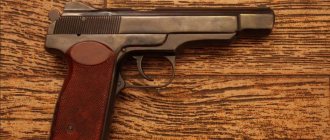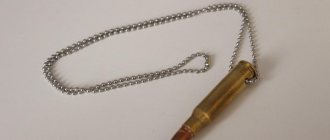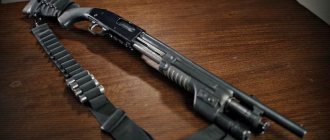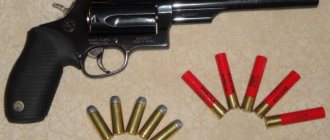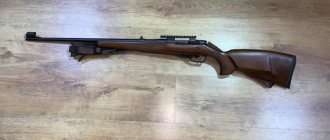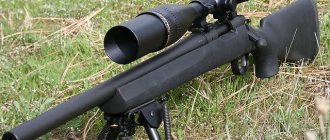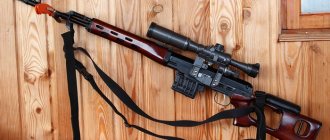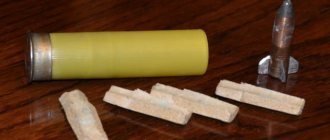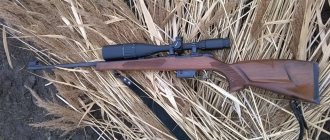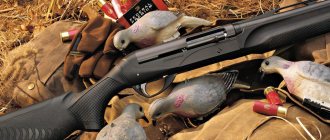Time to read the material: ~ 23 minutes
The caliber is the internal diameter of the bore (for a smoothbore gun). For a rifled barrel, this concept refers to the diameter of the barrel drilled along the fields. When selecting suitable hunting equipment, it is important to follow a simple rule: the larger the game, the larger the caliber should be. This rule will ensure, among other things, the safety of the shooter himself, because an angry predator that has not been killed by small bullets poses a danger to the hunter. It is undesirable to shoot fur-bearing animals with large bullets due to the formation of too wide a wound channel and, as a consequence, damage to the skins and economic inexpediency.
Review of popular calibers
There are many sizes of weapon ammunition. When it comes to rifled guns, the most commonly used types are:
- — 5.6 mm (22-LR) – used for shooting sports and hunting rodents, minks, sables, squirrels, etc.;
- - 5.6x39 (Russian development) - produced either with a bullet made of a full metal jacket (with it you can go after squirrels, muskrats, minks, sables, otters and other fur-bearing animals), or with a semi-jacketed bullet (optimal for catching medium-sized animals);
- — 223 Remington – suitable for catching medium-sized animals:
Carbine Rifled CZ 527 Lux 223 REM
- - 243 Win - showed the best results while hunting live targets weighing up to 150 kg:
Sako 85 s Varmint Laminated Stainless .243Win + Apel EAW
- - 7.62×39 - it was for this standard size that the legendary Kalashnikov assault rifle was developed, it is produced in versions with semi-jacketed and shell bullets, and has great penetrating ability and energy;
- - 308 Win - carbines with this barrel diameter across the fields are suitable for shooting rodents and small game, ungulates from a long distance - valued for their versatility:
Carbine Rifled ELK 7-1
- - 7.62x54R - go with it for large and medium-sized game. This is one of the popular calibers, on the basis of which a new version was invented for civilian rifles, which will be discussed in detail in the further part of the text;
- - 9.3×62 - is chosen by many experienced fishermen for shooting large and medium-sized game.
As for smoothbore guns, the most popular are three calibers: 12, 16 and 20. Moreover, the first option is the most common. 12'' shotguns are not limited in the type of shells used, the size of shot and buckshot. This allows you to shoot at all kinds of game using cartridges with different fillings. In addition, twelve gauge is suitable for beginners.
Smoothbore shotgun IZH-26 caliber 12
Shotgun Sauer caliber 16
New calibers have recently been added to the options listed above - 366TKM and 9.6*53 Lancaster. Let's look at them in more detail:
366-TKM
366-TKM-Lancaster
Choosing a scope for a rifled hunting rifle
It should be recalled that buying a rifle is only half the battle; you have to purchase a scope for it. There is a large selection of sights for rifled weapons, they are:
- by type, sights are day and night, and night sights differ in the principle of operation: image intensifier, digital, thermal imaging
- by the diameter of the lens, the larger the diameter of the lens, the greater the aperture of such a sight, with such a sight it is better visible at dusk and at night
- by magnification, the higher the magnification, the greater the magnification of the sight, the greater the distance you can shoot
- by type of reticle
- by the presence or absence of reticle illumination
There is an unspoken rule that the cost of the rifle should correspond to the cost of the scope mounted on it. They don’t put a cheap scope on an expensive rifle and vice versa. If you shoot with an expensive rifle but use a cheap scope, you will not be able to unlock the full potential of your rifle, nor will you be able to grow as a shooter. A good rifle needs a good scope!
366-TKM and 9.6/53-Lancaster – calibers of the 21st century
These standards were developed based on 7.62x39 mm and 7.62x54 mm. Similar to those from machine guns and rifles, bullets of the calibers in question are stabilized during flight by the rotation obtained due to the special configuration of the barrel.
The creation of new products was carried out by an Udmurt company - Closed Joint Stock Company "Tekhkrim". It specializes in the manufacture of cartridges for all types of shotguns and the production of weapons for personal defense, special equipment for special services, and has over 14 patents for inventions. In addition, Tekhkrim CJSC is a developer of standards in the field of weapons. It was this enterprise that developed national GOSTs:
- — 28653‑2018,
- — 50741-95,
- — 50742-95,
- — 50743-95,
- — 50743‑2019,
- — 51886-2002.
Cartridges for smoothbore weapons 366 TKM copper expansion bullet
Cartridges for shotguns 9.6/53 Lancaster shot in a plastic container
366.TKM
The TekhkrimMolot caliber (366 TKM) was developed and first presented to the public in 2014. Initially, it was intended for the so-called exception weapon (paradox), in which the rifled part (and its length does not exceed 14 cm) is only at the end of the barrel. Federal Law No. 150 classifies such weapons as smooth-bore. Subsequently, .366TKM appeared for Lancasters.
In fact, these weapons were specially created taking into account the shortcomings and controversial issues in Russian legislation. The target audience of the products in question are novice hunters and athletes who want to get a gun with ballistics almost the same as in a rifled carbine, but at the same time do not want to wait the 5 years required by law. Development was carried out for smooth-bore variations of the SKS carbines (the new model was called VPO-208) and AKM (the newly created design was called VPO-209) by order of the Vyatka-Polyansky arms production plant "Molot-Weapon".
The first carbine produced for the 366TKM caliber was the VPO-208 Paradox. It proved itself very well, had (and still has) very good demand in the market. After that, many weapon models were developed under 366TKM by various weapons companies.
A new, more powerful 9.6x53 Lancaster was proposed by Tekhkrim specialists in 2022. Its muzzle energy and initial velocity turned out to be too high for the Paradox muzzle attachment, which led to the bullet breaking off the rifling. To solve the problem, the developers used Lancaster drilling - a special case of oval drilling of a smooth barrel channel, in which there are two wide grooves in the barrel, gradually turning into fields. Such a weapon design, according to the legislation of the Russian Federation, is classified as smooth-bore. Almost immediately, along with the 9.6/53 caliber, Tekhkrim specialists begin experiments with .366TKM. Thus, by the end of 2022 and for 2022, we have 366 TKM for the Paradox drill type (with a cutting pitch of 500 mm) and .366 TKM for oval screw drilling.
366-TKM
Remarkable facts about "366-TKM"
Despite the number 366 in the name, the actual barrel diameter for this cartridge is 374. This phenomenon is explained by the fact that the caliber underwent minor modifications after the patent was received. By slightly widening the bore, the developers managed to achieve better stability of the bullet in the rifling.
In terms of technical parameters, the 366 TKM is close to its rifled counterpart: 7.62 x 39, and the length of the cartridge case is identical to the length of a traditional Kalash cartridge - 37.5 mm.
Tracers
This type of bullet is used exclusively for rifled weapons, only for military purposes. The main distinguishing feature is that the bullet glows in flight. More precisely, it is not itself that glows, but a special combustible mixture. In the back there is a recess filled with a complex chemical composition. When the gunpowder ignites, it also lights up. As a result, when a bullet flies, it leaves a clearly visible trail of fire behind it.
Initially, the tracer was used primarily for easy adjustments, for example, in ammunition for anti-aircraft guns. It is no coincidence that in films about the Great Patriotic War you can often see fiery bullets going into the sky where enemy planes are flying. Subsequently, tracer bullets for machine guns appeared. They are often used for target designation - if you need to show a machine gunner or artilleryman the direction of fire.
But experienced fighters found other uses for them. For example, when loading an AK magazine, they load the first 2-3 rounds with tracer bullets. In combat, it is difficult to remember how many rounds are left in the magazine. But when they see the tracer, they quickly realize that it’s time to reload, so as not to remain unarmed in front of the enemy.
You can identify such a bullet by its marking – green nose.
Which version of weapon to buy under “366TKM”
A very large selection of weapons that use .366TKM cartridges as ammunition is offered by . As mentioned earlier, it was this enterprise that first began to develop weapons for the 366-TKM. And it all started with the VPO 208 model, which has a paradoxical cut. Later, another version of the smoothbore AK from Molot appeared - the VPO 209. Its reliable automatic operation and low price made the model the most popular among all carbines in 366 caliber. The design of the VPO-209 completely replicates the design of the army version, with the exception of the reworking of the trigger (to make it impossible to conduct automatic fire) and the replacement of the rifled barrel with a smooth one, with a paradox. The carbine weighs 3.6 kg with a magazine and 3.2 kg without it, and has a total length of 883 mm. The barrel length is 415 mm. All components are identical to the original ones, there is even a pencil case with care accessories. Available with Lancaster drill or for use with a paradox nozzle. But in VPO 212 (Paradox), the outlines of the AK are guessed with great difficulty. The rifle has a long barrel (520–650 mm) and allows for accuracy of up to 40 mm at 100 m (these are excellent indicators for the caliber in question). The VPO 215 bolt gun with a paradox attachment is an ideal option for marksmanship, hunting in the mountains and hunting ungulates.
In addition to the products of the Vyatka-Polyansky plant, the following weapons are suitable for 366 TKM:
- 1. AK-366 from . Notable for its minimal modifications to the original design of the famous Kalashnikov assault rifle. In essence, these are army machine guns that have been re-barreled and deprived of the automatic fire function and have been removed from the balance sheet. On some models you can even find inscriptions engraved by conscripts using improvised means. Available with Lancaster drill bit.
- 2. TG-2 - the Kalashnikov concern presents a smooth-bore version of the Saiga-MK rifled carbine. Has a “Paradox” type drill.
Armor-piercing
Another rather interesting type of bullet. Used to defeat enemies wearing body armor, as well as those hiding behind solid objects, such as the body of a car.
The device is quite simple. The top layer (shirt) is made of lead - this provides sufficient weight. Well, the material for the core is steel, most often heat-strengthened.
When hit, the lead jacket breaks through the barrier or remains outside if it is too hard. But a thin, high-strength core pierces it, hitting the enemy.
Today, armor-piercing bullets are produced for almost all types of rifled weapons: machine guns, rifles, pistols. It is not surprising, since more and more often the enemy wears body armor and other personal protective equipment. And combat in the city often involves the use of various shelters. If the fire is conducted using armor-piercing bullets, then the likelihood of hitting the enemy in cover increases significantly.
Standard army armor-piercing bullets for AKs (the most common in our country) also combine a tracer and an incendiary mixture. They are marked accordingly - a black nose with a red rim.
Review of ammunition for 366-TKM
The following types of cartridges are compatible with the .366-TKM caliber:
- — semi-shell “Kion 13” or “Kion 15”, “Konus”;
- — in a brass shell – FMJ and FMJ-2;
- - all-metal - “Etna” or “Eco”;
- — lead - “Dary”;
- - shotguns;
- - with rubber bullets.
Cartridges for smoothbore weapons 366-TKM semi-jacketed bullet Kion 15
Cartridges for smoothbore weapons 366-TKM hunting with an all-metal ECO bullet
Traumatic cartridges 366-TKM with rubber bullet
Characteristics of cartridges for 366-TKM:
| Model | V0, m/s | Bullet weight, g | Distance between the two most distant bullet impact points in a group of shots, mm | Shot number/diameter |
| Kion 13 | 650 | 13 | 40 | |
| Kion 15 | 600 | 15 | 40 | |
| Cone | 610 | 15 | 70 | |
| FMJ | 600 | 14 | 65 | |
| FMJ-2 | 650 | 13 | 50 | |
| Dary | 550 | 13,5 | 75 | |
| Eco | 810 | 6,5 | 80 | |
| Etna | 630 | 12,2 | 35 | |
| Fraction | 500 | 6,2 | 10/1.75 mm |
All-metal Eco bullets are used (with a 500 mm Paradox attachment) for amateur shooting and hunting small animals.
The Kion semi-jacketed bullets have a radius shape with an expansive recess. Their durable shell is covered with a thick layer of copper, which ensures uniform opening and preservation of mass, and helps reduce barrel wear. “Cone” cartridges are one of the most beloved by hunters, but they are currently out of production due to outdated manufacturing technology. They can be replaced with the Kion, Dary or Eco models.
FMJ-2 is a specially designed bullet. To make it, you need several types of metals and metal alloys: lead core, brass and bimetal for the shell.
Dary ammunition received an anti-friction polymer coating. They, like FMJ, are recommended to be used with a Paradox choke tube (rifling pitch 500 mm).
Etna bullets are made of soft copper, which ensures their reliable expansion in a ballistic environment. Due to the fairing and manufacturing precision, their accuracy is 1.5–2 times higher compared to other types of bullets.
In addition to the original bullets from Tekhkrim, any 375 caliber cartridges can be used with the carbine.
When did they first appear?
It would seem that the answer to this question is very obvious - the first bullets appeared at the same time as the first firearms. But actually no. As excavations show, the first bullets appeared in Ancient Greece, half a thousand years BC and even earlier.
Of course, firearms did not exist then. But the military and hunters actively used slings. Most often, they were loaded with ordinary stones of suitable size - a very cheap consumable material that can always be found underfoot. But over time, lead bullets became increasingly popular. Small in size, very heavy, they inflicted truly terrible wounds, hitting open areas of the body. They could even penetrate wooden shields, hitting people hiding behind them.
Yes, such ammunition was more expensive than conventional stones. But its effectiveness was much higher. So we can say with confidence that bullets appeared long before the first shot from a firearm thundered on the planet.
9.6x53 Lancaster
A new caliber for smoothbore weapons appeared in October 2017, and instantly gained popularity among Russian hunters. Several factors contributed to this. First of all, the popularity of the “younger brother” is 366 TKM. In addition, the new product comes out with several types of weapons for it (remember that initially only one gun was suitable for .366TKM - the VPO-208 carbine). By the time the 9.6x53.Lancaster was released, several types of weapons for it were presented on the market:
- — semi-automatic devices in the “Vepr” form factor with different barrel lengths;
- - KO-44 - a screw carbine converted from a Mosin rifle with a barrel length reduced to 520 mm.
Subsequently, the range of weapons in the considered caliber was replenished with a carbine from the “Jager” line and a TK598 Mauser. Buyers immediately appreciated the possibility of such a huge selection.
Currently you can buy for this caliber:
- 1. VPO 221-01 Vepr and VPO 221-02 with barrel lengths of 520 and 590 mm;
- 2. KO-044 from Molot-Arms (has a barrel length of 510 mm);
- 3. VPO Vepr-223 (600 mm);
- 4. hunting rifles VPO-222, VPO-220;
- 5. vertical double-barreled shotgun TK 527 M from Tekhkrim and many other models. The choice is huge.
The very need to develop the 9.6x53 Lancaster is dictated by the need to obtain more powerful muzzle energy. Indeed, for a number of technical reasons, such as the mass and dimensions of the bullet, the volume of the case and the pitch of the rifling, it is impossible to increase the cartridge power above 2.4–2.5 kJ in the 366 TKM. Essentially, the 366.TKM inherited the energy of its prototype - 7.62x39. It was necessary to create something more powerful. This is how the 9.6x53-Lancaster appeared. Its prototype was 7.62x54. At the same time, the 9.6x53 Lancaster and 7.62x54 cartridges differ slightly in the design of the cartridge case, which was done due to state requirements (so that it would be impossible to install 7.62x54 ammunition into smooth-bore weapons).
The number “nine point six” in the name indicates the size of the bullet after it is released from the barrel. Moreover, initially it has a diameter of 10.3 mm.
366-TKM-Lancaster
Incendiary
What other types of bullets for rifled weapons exist? Here we cannot fail to mention the incendiary ones. In design they resemble tracers. However, they have a larger glass for the incendiary substance. In addition, it differs in composition. If the main thing in a tracer is what the burning composition should do (glow), then the more important property here is arson. Therefore, thermite or phosphorus is used as an incendiary substance. On contact, it easily sets fire to fuel cans and barrels, dry grass, haystacks and other flammable materials.
The marking is quite simple - a red nose. However, in recent years, simply incendiary bullets have practically not been used. They are being replaced by the combined ones described above. This makes it possible to more effectively pierce fuel containers, for example, car gas tanks, and then set them on fire.
Review of bullets for 9.6x53 Lancaster
Several types of cartridges have been developed for the 9.6 x 53 Lancaster:
- — shell: FMJ-15 and FMJ-18;
- — semi-shell: SP-18 (PK) and “Kion-18”;
- - expansive - “Swift”;
- — buckshot;
- - fraction.
All of them are strictly designed for smoothbore 9.6 x 53 Lancaster.
Cartridges for 9.6/53 Lancaster smoothbore weapons with a jacketed bullet
Cartridges for 9.6/53 Lancaster smoothbore weapons with semi-jacketed bullets
Cartridges for shotguns 9.6/53 Lancaster buckshot in a plastic container
Cartridges for shotguns 9.6/53 Lancaster shot in a plastic container
The table below shows their main characteristics.
| Cartridge | Initial speed, m/s | How much does a bullet weigh, g | Dispersion diameter, mm | Buckshot/shot diameter, mm |
| FMJ-15 | 750 | 14,8 | 50 | — |
| FMJ 15 (US version) | 600 | |||
| FMJ 18 | 650 | 18 | 35 | — |
| SP-18 PC | ||||
| Kion-18 | ||||
| Swift | 600 | 16 | – | |
| Buckshot | 490 | 8 | ||
| Fraction | 500 | 18 | 2,5; №7 |
The cartridges are intended for hunting large and medium-sized animals from a distance of up to 150 m. But there are exceptions. For example, version FMJ 15 US (reduced speed). They were developed by specialists specifically for hunting small animals (weighing up to 100 kg). By reducing V0, the volume of the temporary pulsating cavity is reduced, which in turn leads to a decrease in the volume of the wound channel and the diameter of the inlet. Using bullets with reduced velocity will allow you to:
- — reduce recoil force;
- — avoid causing unnecessary damage to targets;
- — increase the safety of the weapon’s resource;
- — maintain accuracy identical to standard bullets.
PC ammunition (increased accuracy) deserves a separate discussion. They can be easily distinguished from other 9.6x53 Lancaster cartridges by their markings - the inscription PC on the cartridge case and the “high-strength product” sticker on the packaging. In addition to improved accuracy characteristics (which is confirmed by tests carried out by Techkrim specialists on ballistic systems), they have reduced tolerances for the weight of gunpowder and bullets. The cartridge is equipped with Tubal 3000 powder and SP18 bullet in a brass jacket.
Ammunition 6.8*53 Lancaster with the Swift bullet is notable for its increased braking effect, which is achieved by a special design: 6 concentrators on the shell and an expansive cutout on the bullet.
Buckshot and shotgun cartridges expand the capabilities of the 9.6/53 Lancaster. They can be used for hunting birds and small animals. At a distance of 35 m, the spread of buckshot is 0.4 m. From a distance, buckshot pierces through a pine board 50 mm thick.
Bullets for snipers
What types of bullets are there? Separately, it is worth mentioning the sniper ones. The best army shooters have to shoot at long distances - often a kilometer or even two. Although they are usually trained to hit at a distance of about 400 meters using a standard SVD with a standard PSO-1 optical sight.
And yet, here every shot must be as accurate as possible. Therefore, they take the creation of bullets as seriously as possible. In this case, the most accurate machines are used - a deviation of the center by a fraction of a millimeter or a balance knocked down by a fraction of milligrams will lead to the fact that when shooting at a distance of a kilometer, a bullet fired even by an experienced shooter will move to the side by several tens of centimeters, and this is in no way acceptable.
To avoid imbalance, the bullets are not even marked with paint. Yes, the paint weight is minimal. But even such a small thing can play a decisive role when shooting at long distances.
Of course, there are different types of bullets in 7.62 caliber - one of the most popular among snipers firing at medium and long range. Regular, armor-piercing, incendiary and a number of others. Thanks to this, the shooter gets the opportunity to choose the most suitable ammunition for a particular situation.
